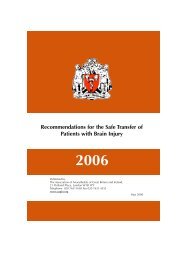TheatrePracticeStandardsGeneric1
You also want an ePaper? Increase the reach of your titles
YUMPU automatically turns print PDFs into web optimized ePapers that Google loves.
Generic Theatre Standard No 15 - WHO Surgical Safety Checklist<br />
Standard: Application of the WHO Surgical Safety Checklist (SSC) in all operating departments.<br />
Standard Statement: All operative procedures performed in trust operating theatres will have the<br />
correct and full application of the WHO SSC process completed and documented by the theatre<br />
team.<br />
Method:<br />
1. List Briefing<br />
• Prior to the commencement of the operating list – participation by the full theatre<br />
team allocated to the operating list<br />
• Staff must introduce themselves to each other by name and role. This information<br />
will be recorded on a visible wipe clean board.<br />
• Any changes to the published Galaxy list must be discussed.<br />
• Any issues related to the organization of the list must be discussed e.g. staffing,<br />
wards, recovery, beds, radiology.<br />
2. WHO Surgical Safety Checklist Theatre and all other General Anaesthetic activity<br />
(See Appendix 4)<br />
• Every Patient should have a completed Pre-Op Assessment and Pre-Op Checklist<br />
as part of the perioperative document prior to transfer to theatre, cataract patients<br />
will utilise the cataract perioperative pathway document.<br />
• Every Patient will have a copy of the WHO Surgical Safety Checklist<br />
• All steps will be read out loud though steps relating to aspiration/airway risks and<br />
blood loss may be treated with discretion.<br />
• “Silent cockpit” principles should be adopted during all steps, all team members<br />
must show respect for the process, be present and fully participate in all steps of<br />
the check procedure.<br />
• It is the responsibility of the senior operating surgeon and the practitioner in charge<br />
of the operating theatre to ensure that the WHO SSC process is completed<br />
accurately and diligently.<br />
3. Sign In – Before Induction of Anaesthesia<br />
• If the senior surgeon has not seen the patient on the ward they must be present at<br />
‘Sign In’. If the senior surgeon has seen the patient it is up to their discretion as to<br />
whether they are present for ‘Sign In’.<br />
• The team will verbally confirm out loud all points detailed on the sign in section of<br />
the WHO Surgical Safety Checklist. Discretion may be used for questions relating<br />
to airway/aspiration risk and blood loss.<br />
• The registered practitioner/delegated person will clearly mark the checklist in the<br />
appropriate place to confirm the check has taken place.<br />
• On completion the registered practitioner will clearly print their name and Sign to<br />
confirm completion of the sign in check.<br />
• The registered practitioner/delegated person will confirm that the correct patient<br />
details are completed on the WHO Surgical Safety Checklist (a patient identity<br />
label may be used).<br />
71





